The Parish Register of the Church of St. Laurence - "Wilfully Eroded" said Mr Bromley of the USA in 1847.
![]()
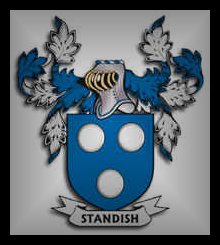
Were the descendants of Myles Standish a founding father of the United States of America wilfully defrauded of their lawful inheritance to the extensive Duxbury Estates in Lancashire England on the death of the last male Standish in England - Sir Frank Standish in 1812? Mr Bromley appointed by Standish family members in the USA to investigate their claim believed that they had been wilfully defrauded - along with many citizens in America and Lancashire England.
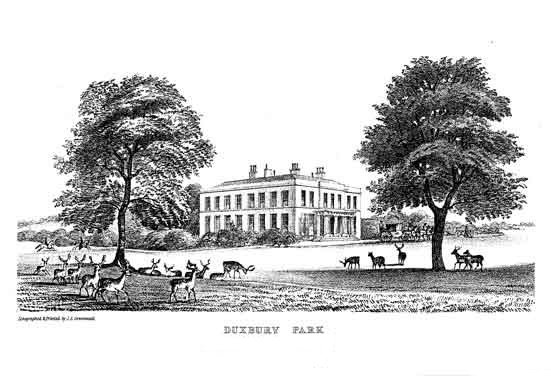
DUXBURY HALL Chorley Lancashire England in 1846 -
the year Mr Bromley was appointed by Standish family members in the USA to investigate their claim.
![]()
The disputed ancient baptismal register of the Church of St. Laurence still exists to day!
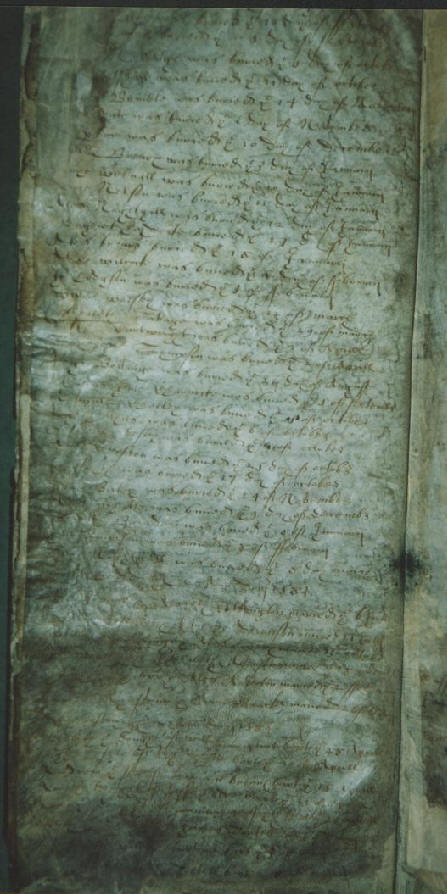
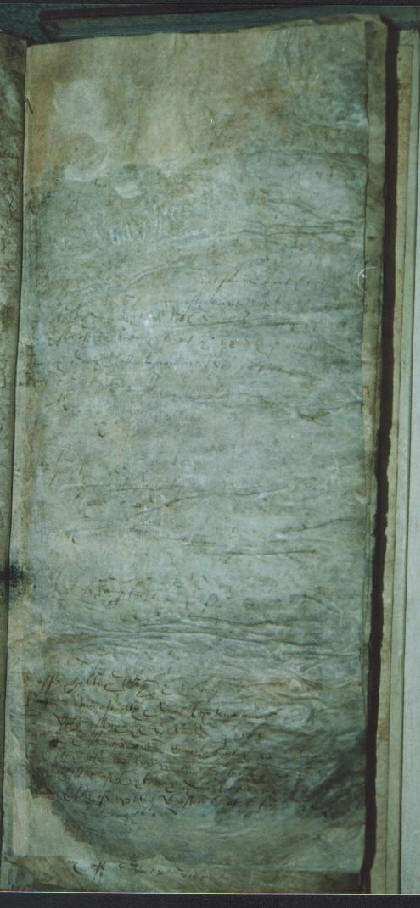
The Baptismal Register of the Parish Church of Chorley - St. Laurence opened at the pages covering baptisms for the year 1584 the year of the birth of Myles Standish. The top part of the page on the RIGHT (births 1584) has been torn off? The page was rebuilt to its original size by the use of tissue paper around 1922. The question of the alleged wilful damage to the Parish Births Register arose upon the death of Sir Frank Standish the last surviving Standish of Duxbury. Several persons put forward claims to be the next in line to inherit the Duxbury Estates including the descendants of Myles Standish in America. Conversely some 60 years earlier when Ralph Standish of Standish Hall, the last male Standish of the House of Standish died not one male came forward from England-Ireland-Isle of Man or America to claim title to the Estates of the House of Standish. The estate passed to his only surviving daughter Celia Standish. The Parish Birth Register at the Church of St. Laurence was a vital reference document for the claimants in search of a valuable inheritance. The fact is well recorded that the top part of the register for births in the year 1584 (the year used for the Birth of Myles Standish) was torn off and other parts eroded to the extent that they are unreadable. Many scholars have commented on the question of natural erosion or fraudulent erosion?
![]()
The Reverend Thomas Cruddas Porteus took a very hard line towards Mr Bromley the Standish Family representative from America in 1846. The Reverend Porteus sets a picture of a rude, conniving American taking advantage of a poor cold Rector who only wants to sit down with a hot dinner?
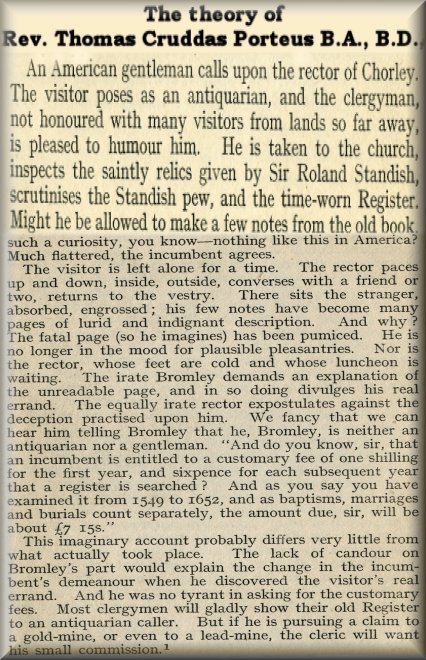
The Reverend Bernard Nightingale said this of the explanation of Rev. Porteus -
The explanation by Mr,Porteus of the defect in the Chorley Parish Register in the years 1584 and 1585 is not in the least satisfactory. The defect is there, and it is a very real one; and, coupled with the fact that no trace of the name can be found in any other register, there is some significance in the occurrence of the defect in the very register and at the very period where, if there were a disposition to destroy the birth entry, we might expect it to be. - Reverend Bernard Nightingale
CHORLEY HISTORICAL
SOCIETY
CHORLEY PARISH REGISTER AND MYLES STANDISH
Much had been written about page 39 in the Chorley Parish Register, which had it been intact, was said would have settled the question of the birthplace of Standish. As it was very little was known of the first 36 years of his life. One historian had remarked that the absence of the name from the page in the register might be due to the ravages of time, but most likely to the blundering fingers of persons, who had in their possession many broad acres, to which descendants of the family were entitled. It was thought that as late as the early part of the last century they went to work using pumice stone to erase the name of Myles Standish from the list of Baptisms and thus effectively preventing his heirs from claiming the estate. If that were true, the heirs were robbed of an estate of the value of £109,000. - CHORLEY HISTORICAL SOCIETY.
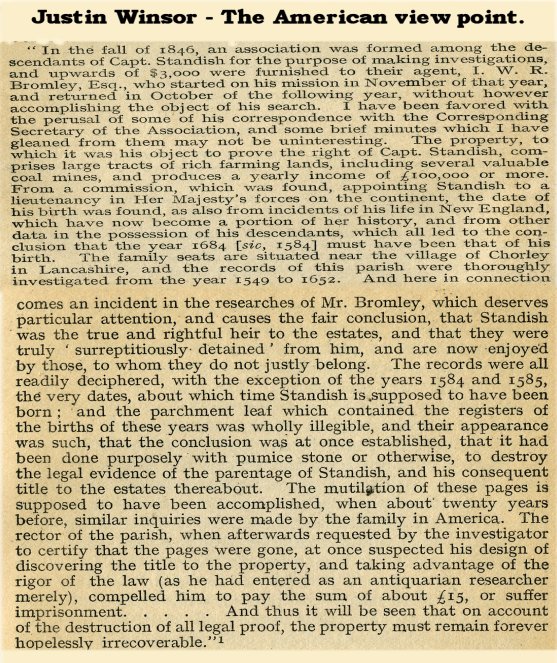
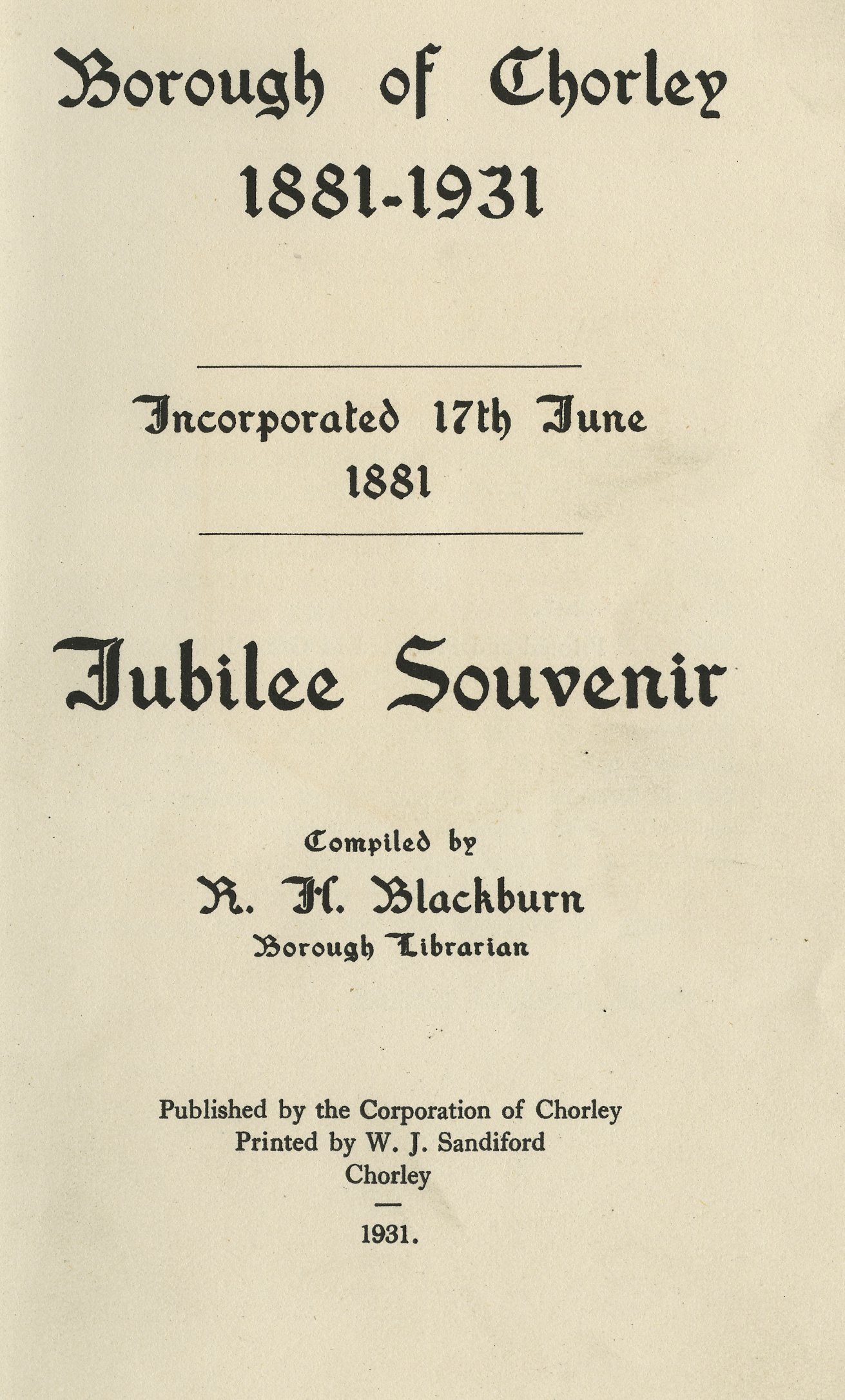
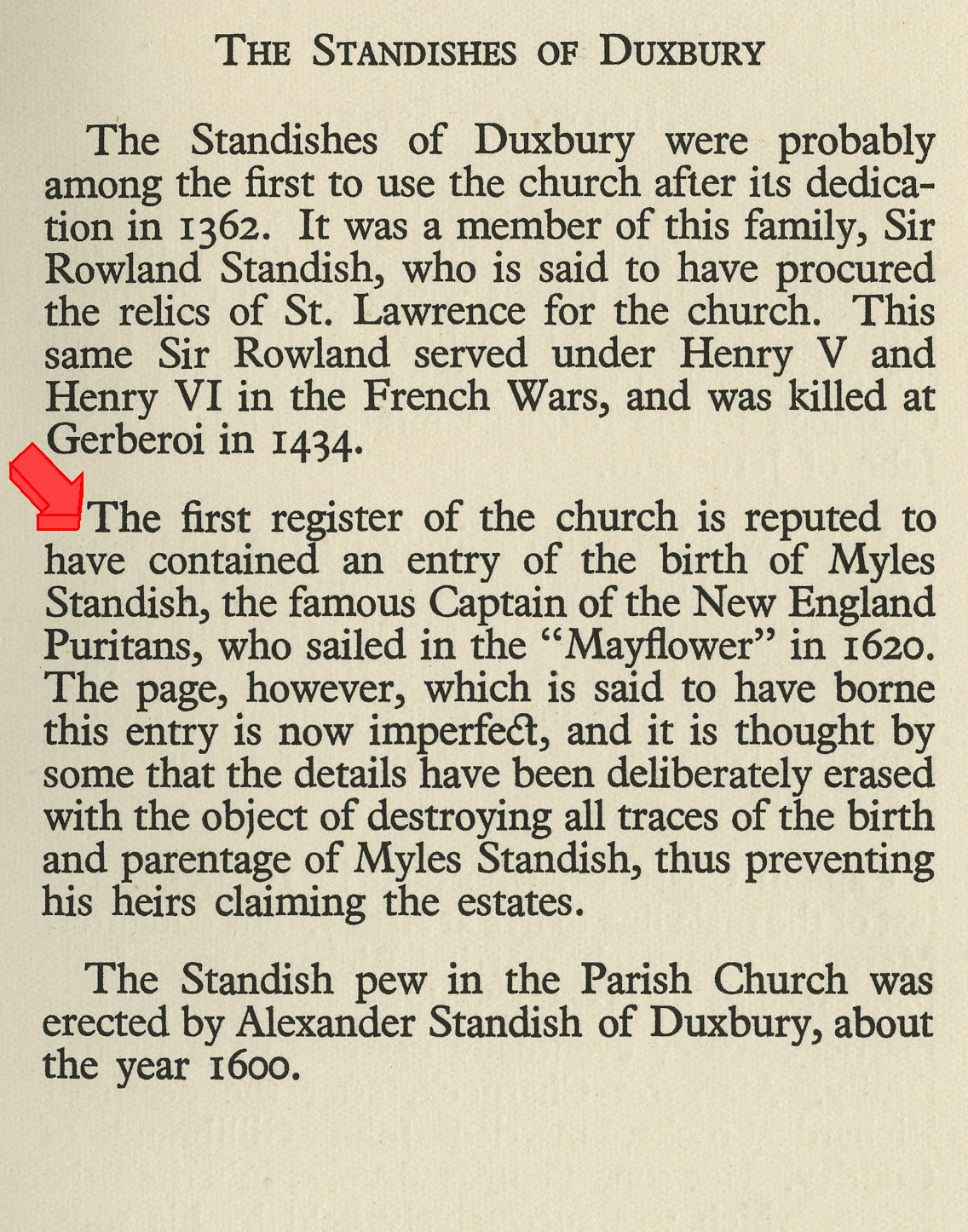
![]()
Webmasters Notes
1846. Mr I. W. R. Bromley of the USA visited Chorley to inspect the Birth register of the Church of St. Laurence to determine if any birth entry in the name of Myles Standish was registered for the year 1584. Mr Bromley was convinced upon inspection of the register that the hand of fraud had wilfully eroded the page containing the birth record for the year 1584?
1871. Gen. Horace Binney Sargent was the orator of the day, and in the course of his tribute to the famous Pilgrim captain he declared: “To defeat the title of his line to lands in England, the rent-roll of which is half a million per annum, the hand of fraud is supposed to have defaced the page that contained the parish record of his birth".
1912. Myles Standish of Boston USA visited Chorley to inspect the Birth register of the Church of St. Laurence and states that it was plain to him that the defect in the register for the year 1584 was due to erasure.
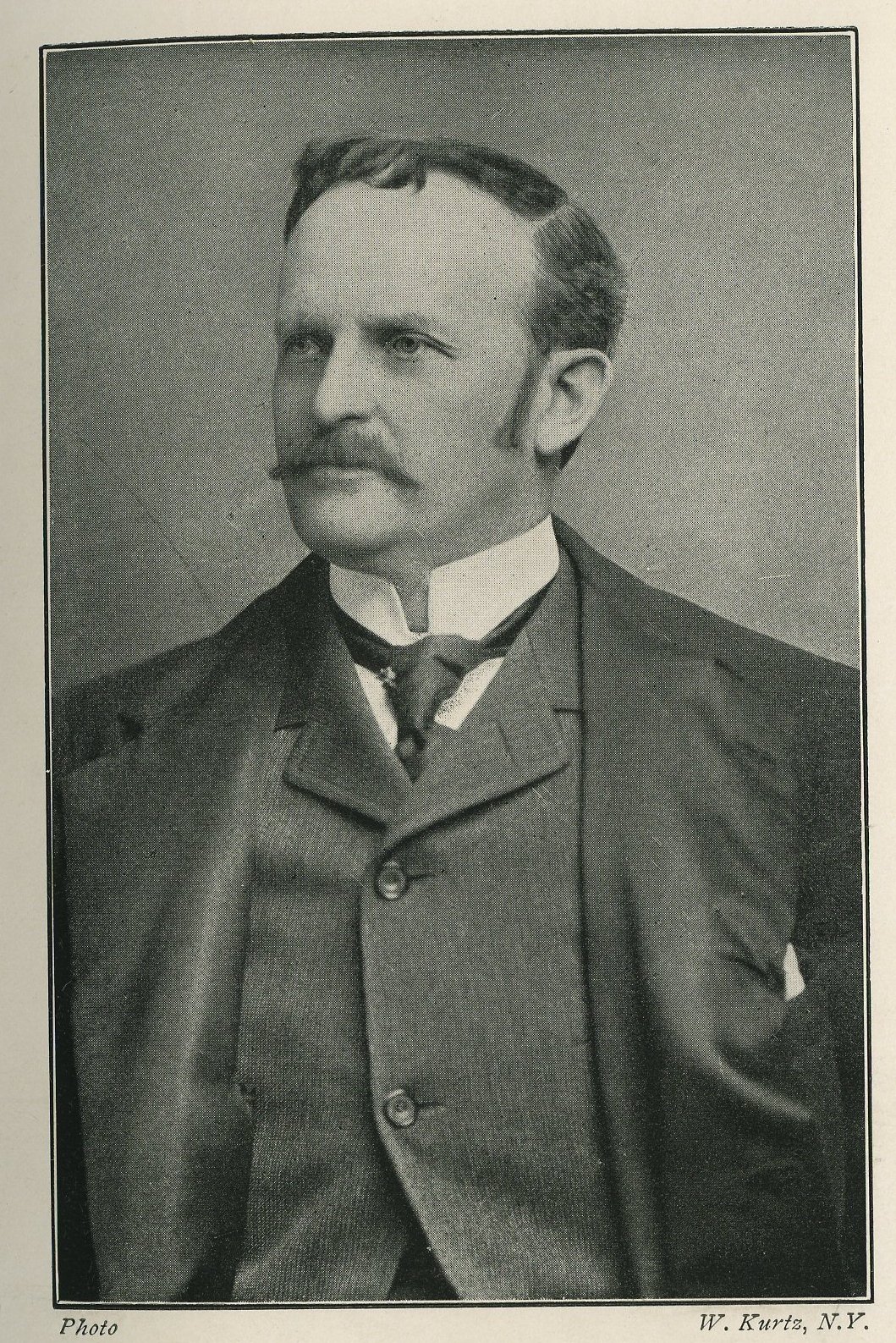
Myles Standish 1912.
1920.
Reverend T. C. Porteus acknowledges in his book “Myles Standish” that the
accusation regarding the claim of the “hand of fraud” is still relevant and
unresolved. The Reverend Porteus then claims to have resolved the accusation in
his book stating - it was just a misunderstanding?

- Reverend T. C. Porteus
1921. The Reverend B. Nightingale indicates that the accusation regarding the "hand of fraud" is not resolved with his statement - " The explanation by Mr,Porteus's of the defect in the Chorley Parish Register in the years 1584 and 1585 is not in the least satisfactory"
![]()
In 1846 Mr I. W. R. Bromley was charge with investigating their claim to lawful inheritance of the Duxbury Estates in Chorley Lancashire England by the Standish family of America. The conclusion of Mr. Bromley was that fraud had taken place and the birth register of the Church of St. Laurence page 39 year 1584 had been wilfully eroded to deny any other lawful claims of Inheritance to be made. No evidence exists to suggest that Mr Bromley ever accused the Rectors of Chorley of any involvement in the wilful mutilation of the birth register. However Mr Bromley did point the finger of suspicion in the direction of the new squire of Duxbury who claimed to be the only lawful descendant and the rightful heir to the inheritance. Another related but less publicised event in 1812 was the sudden and mysterious disappearance of all Sir Frank Standishes legal papers, underlining Mr Bromley’s assertion that fraud had taken place after the death of Sir Frank. The legal papers covered the period 1300 to 1812 and the evidence appears to suggest that the papers were wilful placed beyond the reach of other lawful claimants such as the Standish family of America. The lost legal papers remained out of sight from 1812 until 1965 when they appeared for sale upon the open market and were purchased by Lancashire County Council. Thus the question to be asked is what did the papers of Sir Frank Standish hold to make them disappear in the first place? The answer appears in a document dated 1647 a legal document transferring the dower (all of the Duxbury estates) of Margaret Standish widow of Alexander Standish killed in the English civil war. This legal transfer is to Colonel Richard Standish and the document indicates that this Richard Standish had no legal right of Inheritance to the Duxbury estates thus he was not the brother of Alexander Standish the husband of Margaret. Alexander Standish and his brother and Uncles were all killed in the English Civil War.
Section of the 1647 Dower Transfer
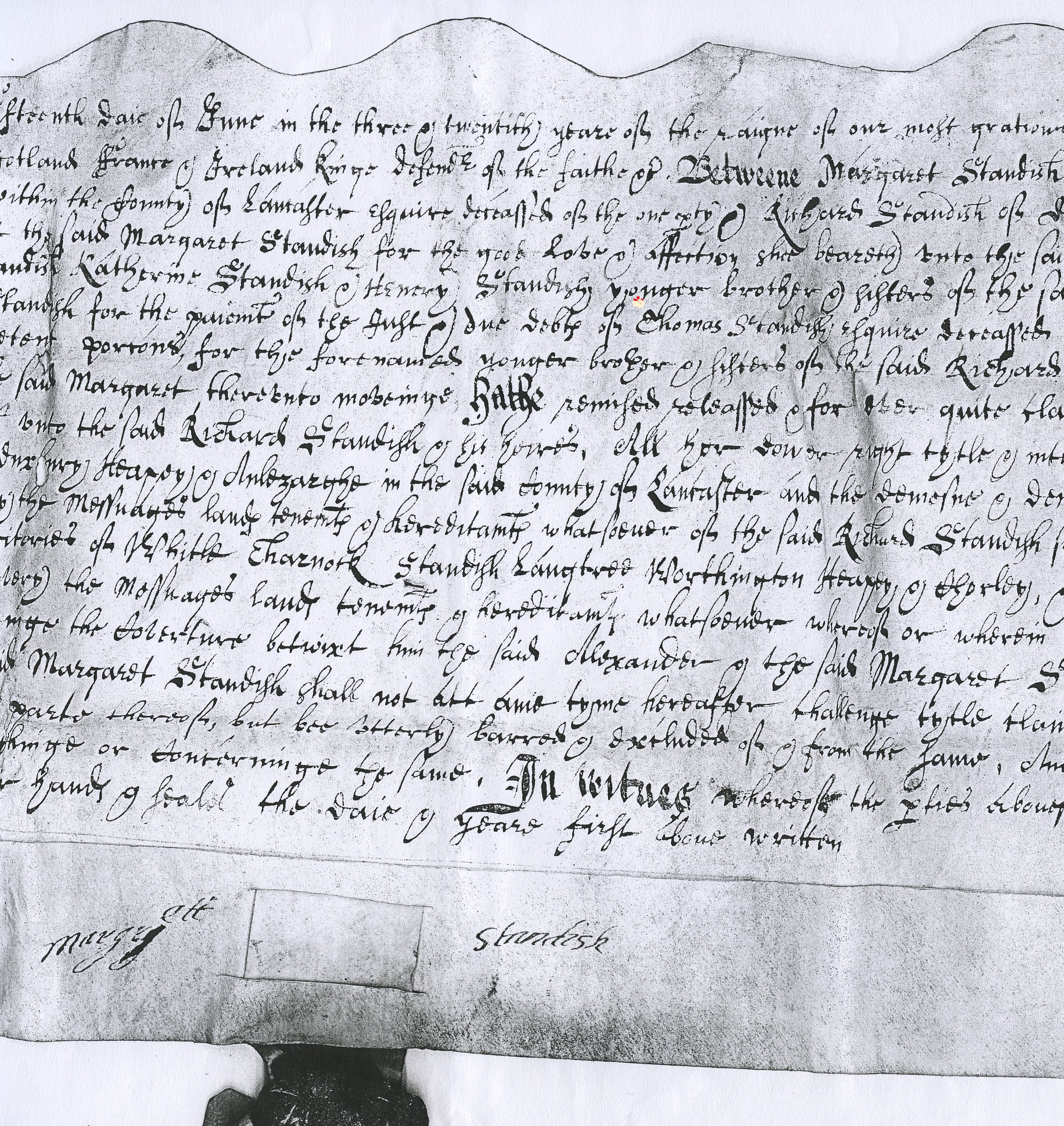
Release of Dower, 1647
Lancashire RO ref DP 397/21/16
This
Indenture made the fifteenth daie of June in the three and twentith yeare of
the raigne of our most gratious Sov[er]aigne Lord Charles, by the Grace of God,
of England, Scotland, France and Ireland, Kinge, defend[e]r of the faith etc,
Betweene
Margaret Standish, widdowe, late wife of Alexander Standish, late of Duxbury
within the County of Lancaster, esquire, deceassed, of the one p[ar]ty,
And Richard Standish of Duxbury afforesaid, esquire, of the other party,
Witnesseth That the said Margaret Standish, for the good Love and affection
shee beareth unto the said Richard Standish, Anne Standish, Dorathy Standish,
Margaret Standish, Katherine Standish and Henery Standish, younger brother and
sisters of the said Richard Standish, and for the better enabling of the said
Richard Standish for the paiem[en]t of the Just and due debtes of Thomas
Standish, esquire, deceassed, his late father, and of the said Alex[ande]r Standish,
and of raisinge some competent porc[i]ons for the forenamed younger brother and
sisters of the said Richard Standish, And for divers other good causes and
Considerac[i]ons her, the said Margaret thereunto moveinge,
Hath remised, releassed, and for ever quite claimed, And by these presentes
doth remise, release and for ever quite claime unto the said Richard Standish
and his heires,
All her dower, right, tytle and interest of dower and demand whatsoever of, in
and unto the Mannors or lor[dshi]pes of Duxbury, Heapey and Anlezarghe in the
said County of Lancaster,
And the demesne and demesne landes thereunto belonginge and appertaininge, and
of, in and unto all and every the Messuages, landes, tenem[en]ts and
hereditam[en]tes whatsoever of the said Richard Standish, scituate, lieing and
beinge within the Townes, Townshipps, p[re]cinctes and Territories of Whitle,
Charnock, Standish, Langtree, Worthington, Heapy and Chorley, and elswhere
within the said County of Lancaster,
And of, in and unto all and every the Messuages, landes, tenem[en]ts and
hereditam[en]tes whatsoever, whereof or wherein the said Alexander Standish had
anie estate of inheritance duringe the Coverture betwixt him, the said
Alexander, and the said Margaret Standish,
And of, in and unto every parte and p[ar]cell thereof,
Soe as the said Margaret Standish shall not att anie tyme hereafter challenge,
tytle, claime or demand anie dower of, in, or unto the said p[re]misses, or
anie parte thereof, but bee utterly barred and excluded of and from the same,
And of and from all suites, acc[i]ons, tytles, claimes and demandes for,
touchinge or Concerninge the same.
In witnes whereof the p[ar]ties abovesaid to these p[re]sent Indentures
Interchangeably have put their handes and seales the daie and yeare first above
written.
Margrett Standish
* 1647 tranfer of dower transcribed by Brooke Westcotte Lancashire Family History & Heraldry Society .
![]()
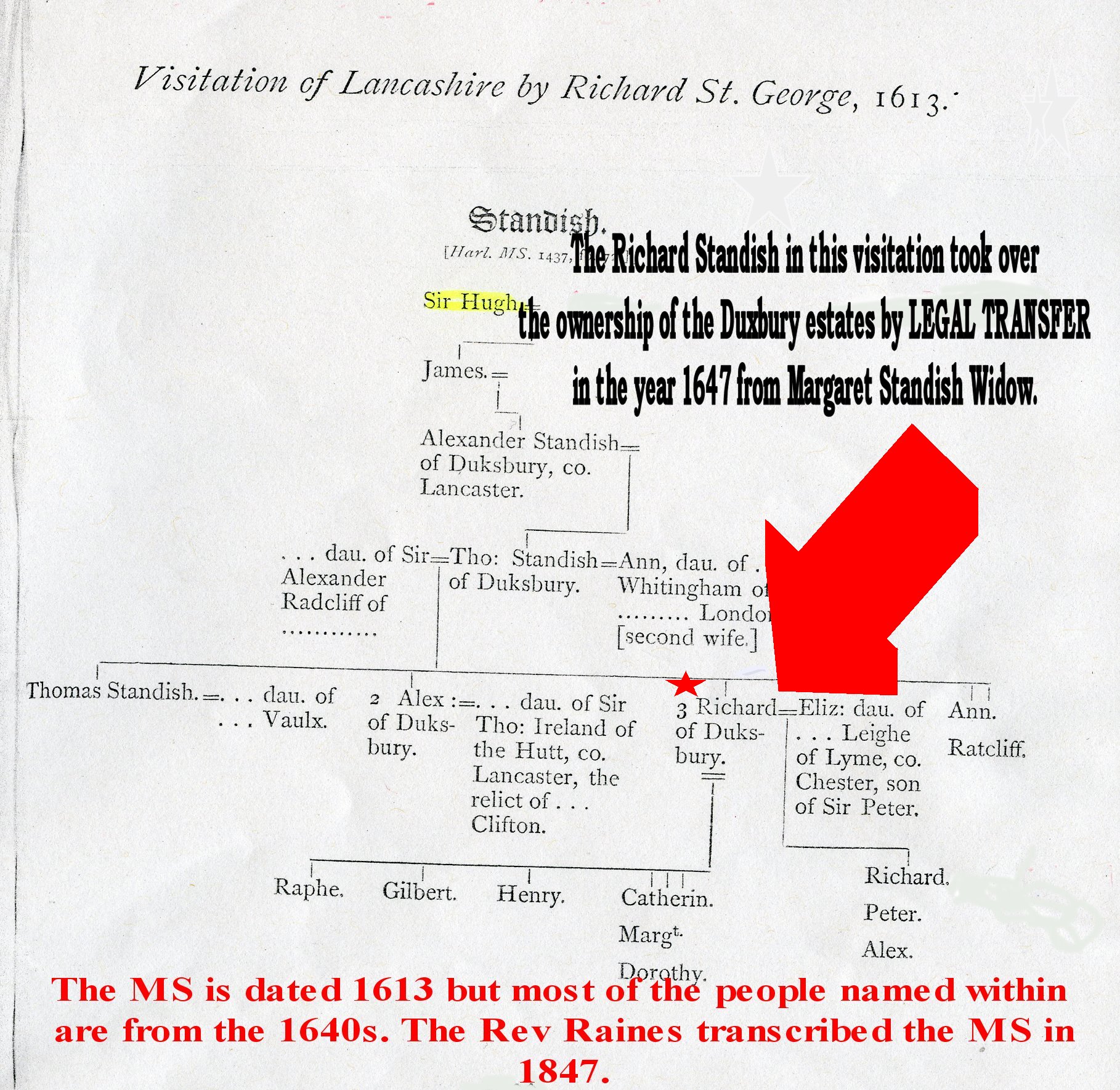
Original document -the questionable 1613 visitation – located by Jim Heyes
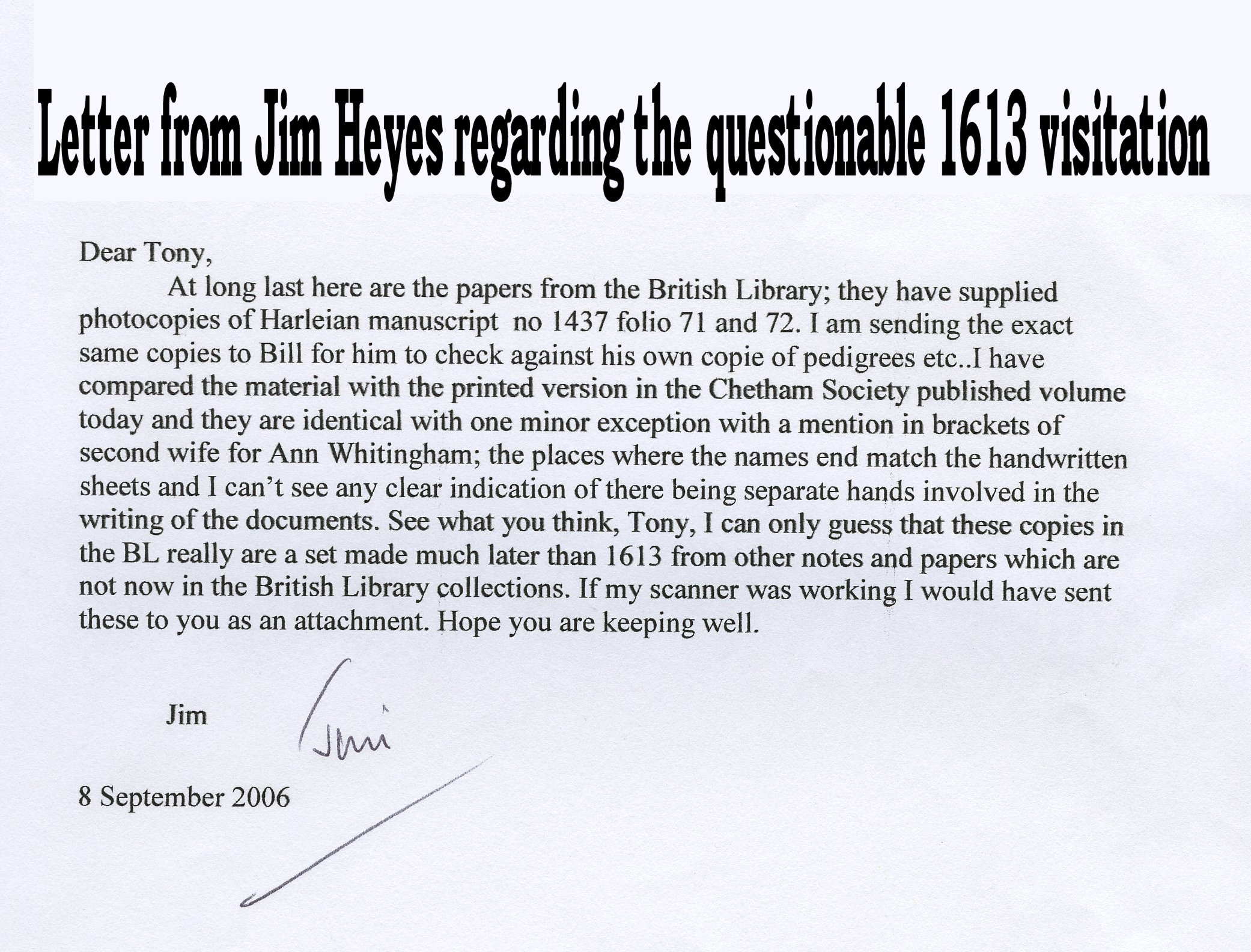
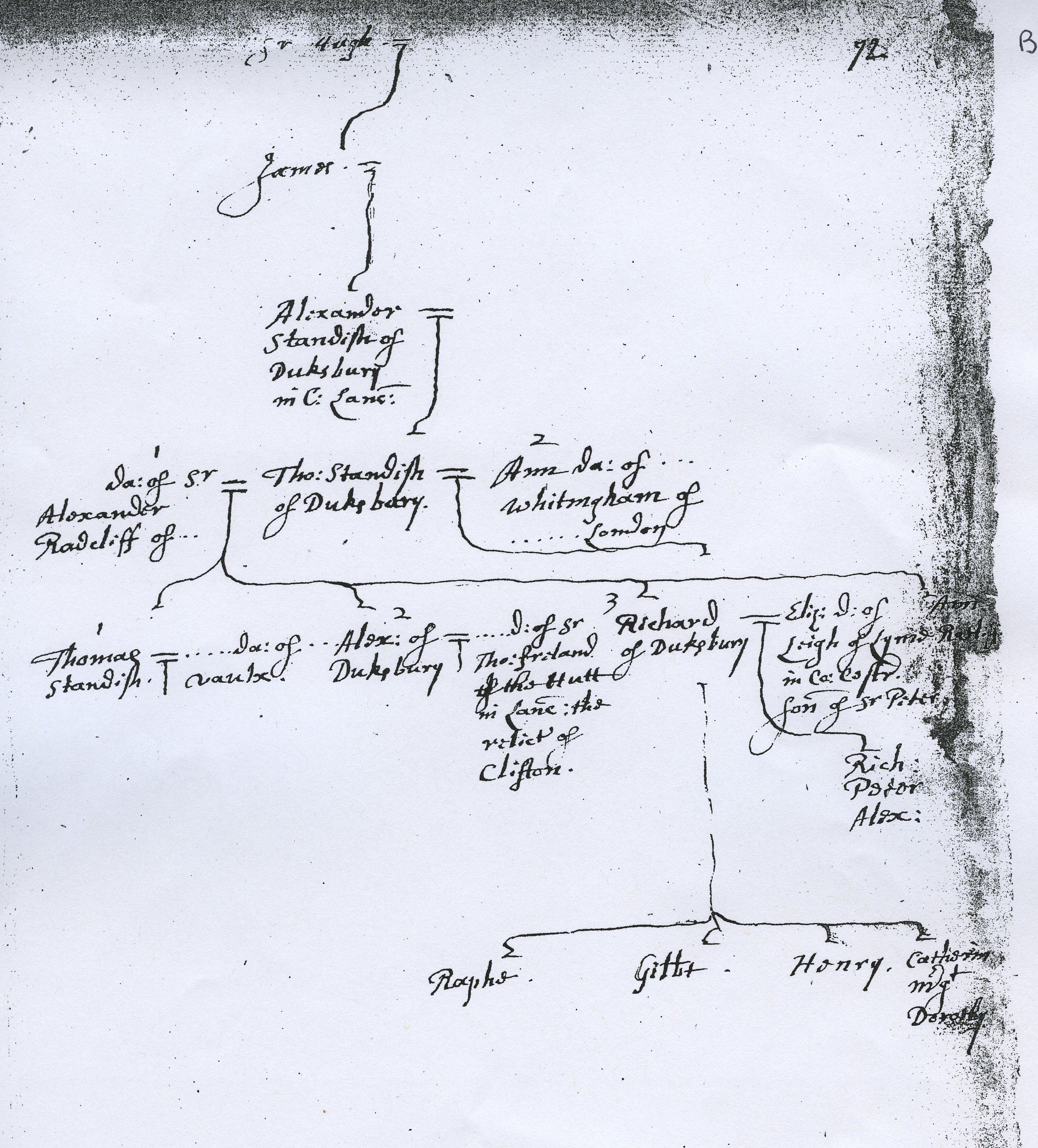
![]()
In 1655 Colonel Richard Standish consolidated his legal title to the Duxbury Estates (obtained by the transfer of the Dower of Margaret Standish) in court and finalised his lawful ownership of the Duxbury Estates for himself and his lawful heirs from 1655 to 1812.
Section of the 1655 Legal Document.

LancashireRO ref DP 397/21/17
This is the finall agreement, made in the Court at Lancaster on Saturday the
four and twentieth day of March in the yeare of our Lord one thousand six
hundred fifty four,
Before Richard Newdegate, one of the Justices of the Upper Bench, And Robert
Hatten, Serjeant at Law, Justices at Lancaster, And others then and there
present,
Betweene Edward May, gent, and Alexander Standish, gent, plaintifes,
And Richard Standish, esquier, and Elizabeth his wife, deforceants,
Of the Mannors of Duxbury, Heapey, Whittle in the woods, Heath Charnocke and
Anlezargh, w[i]th the appurtenances, and one hundred and twenty mesuages, four
water corne Millns, one hundred and twenty gardens, fifty Orchards, one
thousand acres of Land, two hundred acres of meadow, four hundred acres of
pasture, fifty acres of Wood, six hundred acres of Mosse, two hundred acres of
Marsh, four hundred acres of furze and Heath, fifty shillings rent, and
Co[m]mon of pasture, w[i]th the appurtenances, in Duxbury, Heapey, Whittle in
the Woods, Heath Charnocke, Anlezargh, Standish, Langtree and Chorley,
Whereupon a plea of Covenant was su[m]moned betweene them in the same Court,
that is to say,
That the said Richard and Elizabeth have acknowledged the said Mannors, Tenements,
Rent and Co[m]mon of pasture, w[i]th the appurtenances, to be the right of the
said Edward,
As those w[hi]ch the said Edward and Alexander have of the gifte of the said
Richard and Elizabeth,
And those they have remised and quite claymed from them and theire heires unto
the said Edward and Alexander, and the heires of the said Edward for ever.
And moreover the said Richard and Elizabeth have granted, for themselves and
the heires of the said Richard, that they will warant the aforesaid Mannors, tenements,
Rent and Co[m]mon of pasture, w[i]th the appurtenances, unto the said Edward
and Alexander, and the heirs of the said Edward, against them, the said Richard
and Elizabeth and theire heires for ever.
And for this Acknowledgment, remission, quite clayme, waranty, fyne and
agreement the said Edward and Alexander have given to the said Richard and
Elizabeth six hundred pounds sterlinge.
Lancaster
Note.
Final Concord. These were not genuine disputes. A sale
would already have been agreed, but theoretically all land was held "of
the crown" and could not be sold. By fabricating a dispute and
negotiating an "out of court settlement" which was recorded at
Westminster, the purchaser (Edward and Alexander here) got indisputable legal
title subject to a payment of six hundred pounds sterling. If the payment of
six hundred pounds sterling was not paid to Richard Standish, esquire,
and Elizabeth his wife the indisputable legal title remained with Richard and
Elizabeth and their heirs forever.
* Final Concord, 1654/5 transcribed by Brooke Westcotte Lancashire Family History & Heraldry Society
In 1812 the implications of the 1647 document on the right of Inheritance was profound. Any claim of Inheritance by indirect relationship to Sir Frank Standish was limited by a family tree that ended in 1647. Therefore any Standish Family member showing a direct family relationship to the ancestors of Alexander Standish who died in 1647 had a prior claim of inheritance to the Duxbury estates in 1812. Thus the legal papers of Sir Frank Standish would have had a direct bearing on the outcome of any Inheritance claims brought within the jurisdiction of a court of Law.
![]()
Sir
Frank Standish died intestate and without issue
in 1812, Mr. G . Baker, of Ellesmere Hall, near Durham, took possession
of the Duxbury estates in the name of his ward, Frank Hall, who was then a boy
of thirteen. On the balance of probabilities in 1812 it was determined
that Frank Hall a distant cousin of Sir Frank Standish was the lawful person to
Inherit the Duxbury Estate.
Family Tree of Frank Hall.
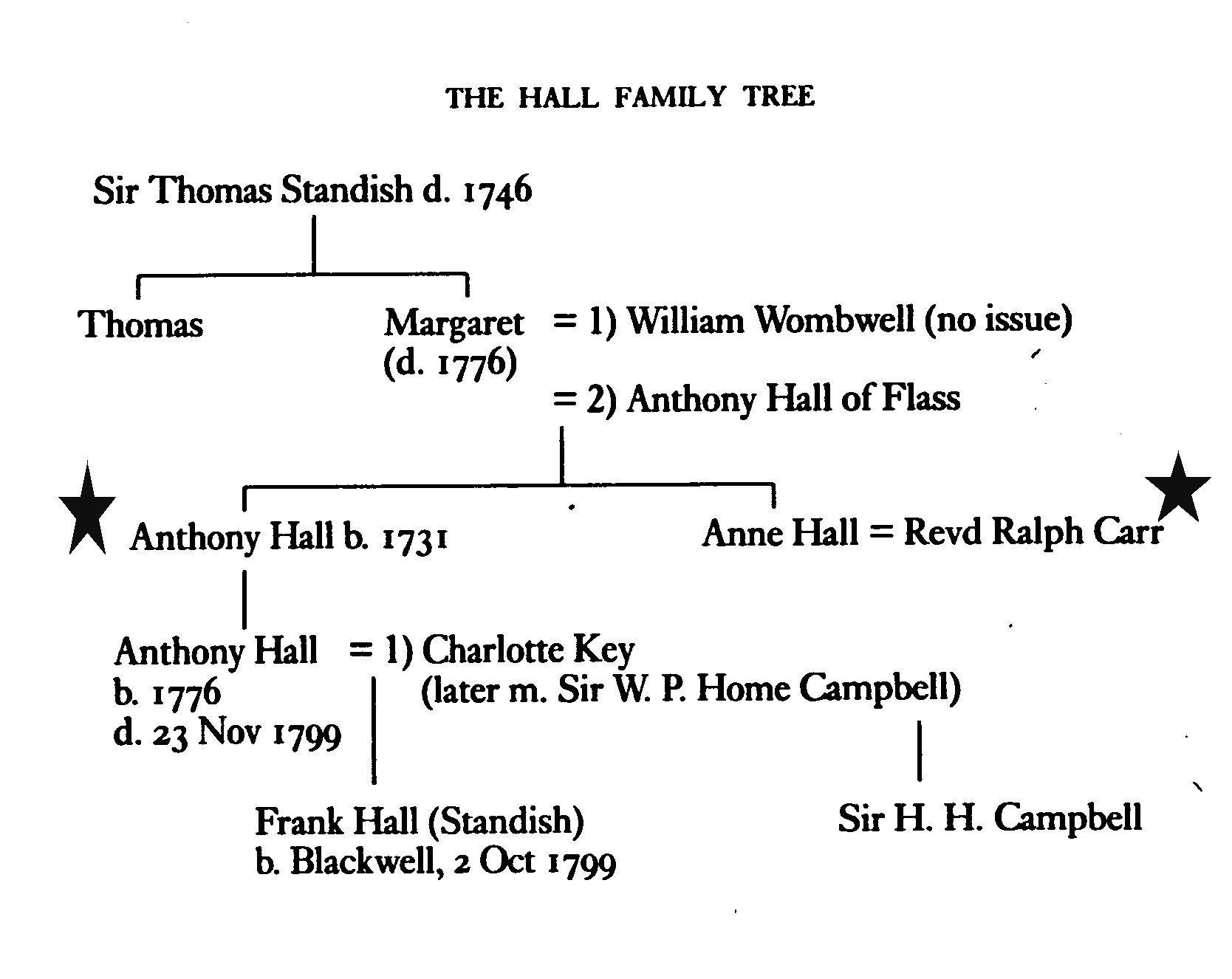
Frank
Hall was only 13 years of age in 1812 when Sir Frank Standish died. Frank
Hall’s father Anthony Hall died just seven weeks after the birth of Frank
making the infant son his heir to a modest estate in County Durham. Frank Hall
consequently had guardians to manage his affairs and protect his interests; Sir
Frank Standish was his guardian in 1807. Another guardian was George Baker. The
Legal case of other associated claimants to the Duxbury Estates stated that
Frank Hall (who had meanwhile delivered a
pedigree into the College of Arms and
by Royal Licence assumed the name of Standish) might be descended from the Anthony Hall who married Margaret
Wombwell, formerly Standish, but he
was in fact the offspring of Anthony Hall by a former union, and
therefore was not of the Standish blood. They did not doubt that the first Anthony had
another son of the same name by Margaret, but contended that this
Anthony went to sea and died unmarried. This
claim was still under discussion when Frank Hall Standish died in 1840; and Mr. Standish Carr,
one of the above-mentioned claimants, was
finally adjudged to be his rightful
successor, taking the surname Standish in lieu of his family name. It is
remarkable that Mr. Standish Carr disputed the right of Mr. Frank Hall Standish
while the latter lived, but allowed him and
his branch the place they had claimed in
the family pedigrees published after 1840.
In
view of the complaints made that Chorley Register of the Church of St. Laurence
was defaced to defeat the title of the rightful
heir, it is interesting to note that the associated claimants in 1835 made a similar assertion about
the Standish Register of the Church
of St. Wilfrid. This was in connection with the baptism of Thomas, son of Sir
Richard and Margaret Standish, of Duxbury, at Standish Church, on
January 16, 1678, they said: “ It is a
curious circumstance that this register has been cut out of the Standish books, and was found among
the returns from that parish to
Chester [Diocesan Registry].”
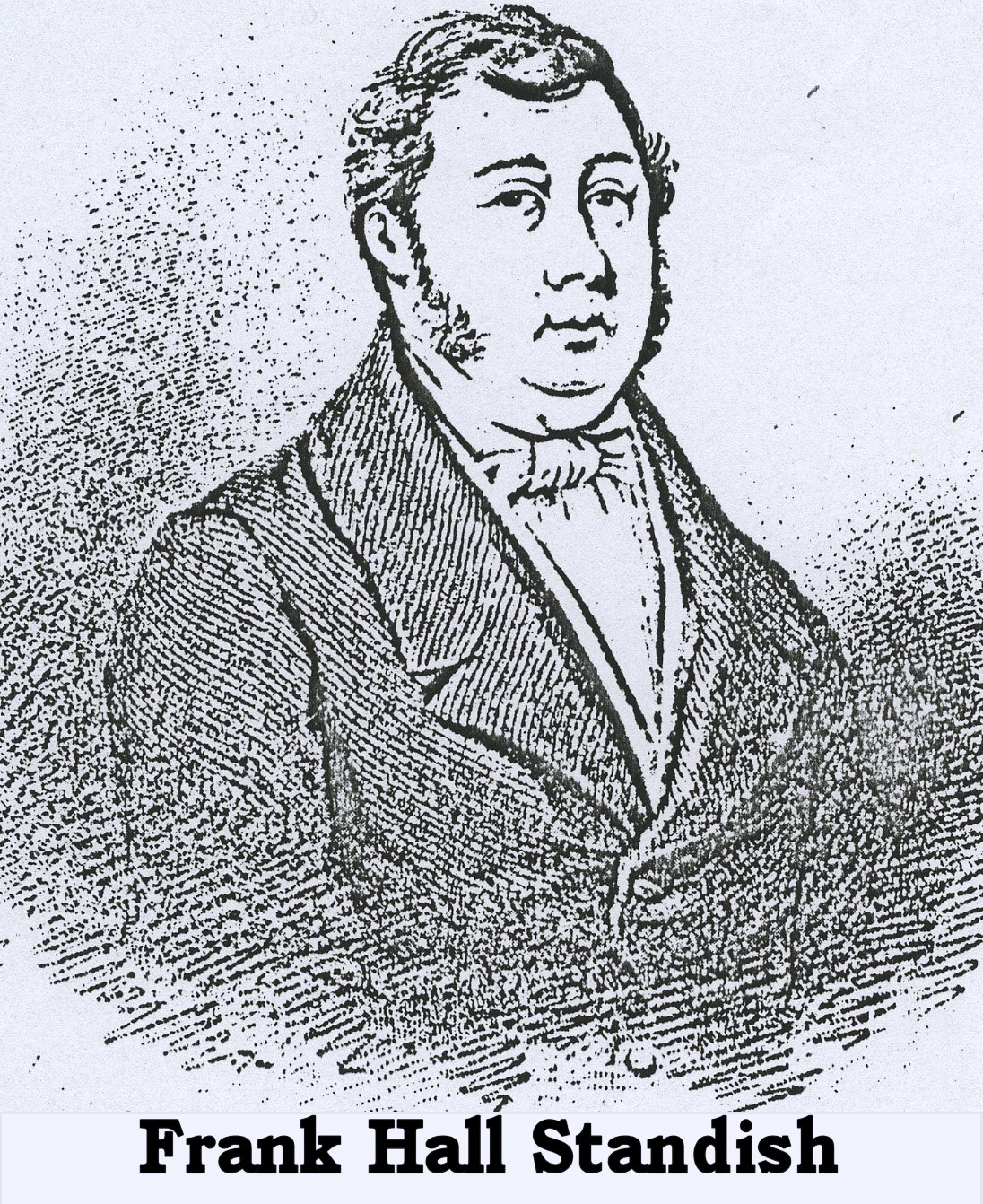
In 1812 it was George Baker who arrived at Duxbury to claim the estates in the name of Frank Hall and thus he was the only person to have access to both the parish register of St. Laurence and the legal papers of Sir Frank Standish. Could the alleged hand of fraud be that of George Baker?
- Webmaster.
The Battle of Duxbury Hall – 1813.
A
certain Thomas Standish of Blackrod, a weaver, claimed to be the right heir,
and assumed the title of Sir Thomas. The present writer has had the loan of a
very elaborate pedigree, illustrated with coats of arms, which was used by the claimant. It shows that Thomas Standish baptised
at Blackrod, 1763, is the “ undoubted heir male “ by the will of Alexander
Standish of Duxbury (died 1622), who married a daughter of Sir Ralph Ashton, of
Whalley Abbey.
Aided
by about a hundred collier friends, Thomas Standish went to Duxbury Park on
June 4, 1813, and dispossessed the resident bailiff. The Preston constables,
who were sent for, proving too weak to drive out the invaders, a troop of horse
soldiers came from Manchester the next day and took the garrison prisoners.
Thomas Standish and some of his leading friends were indicted for riot, and
sentenced to a year’s imprisonment at Lancaster Castle.
For
some time afterwards, however, his sympathisers made demonstrations in the
park, and visited the inn at Yarrow Bridge to drink to his better fortune.
These carousals were known as Duxbury Races and Yarrow Bridge Fair, and some
local laureate set the following verse to a popular tune:—
“ From Wigan the constables brave did repair to Duxbury Races and Yarrow Bridge Fair.
To keep our true landlord our efforts did fail. They carried Sir Thomas to Lancaster Jail.
But we’ll fetch him back. He nothing shall lack. And in spite of the lawyers and Master Frank Hall.
He shall ride in his carriage to Duxbury Hall.”
Three weeks after the siege, another party of Queen’s Bays had to come to Chorley for the further safety of Duxbury Park; and they remained in the vicinity from June until September.
On September 5 in the following year, 1814, the Orange Society from Wigan went to Chorley to meet Thomas Standish on his release from Lancaster Castle.
- Reverend T C Porteus
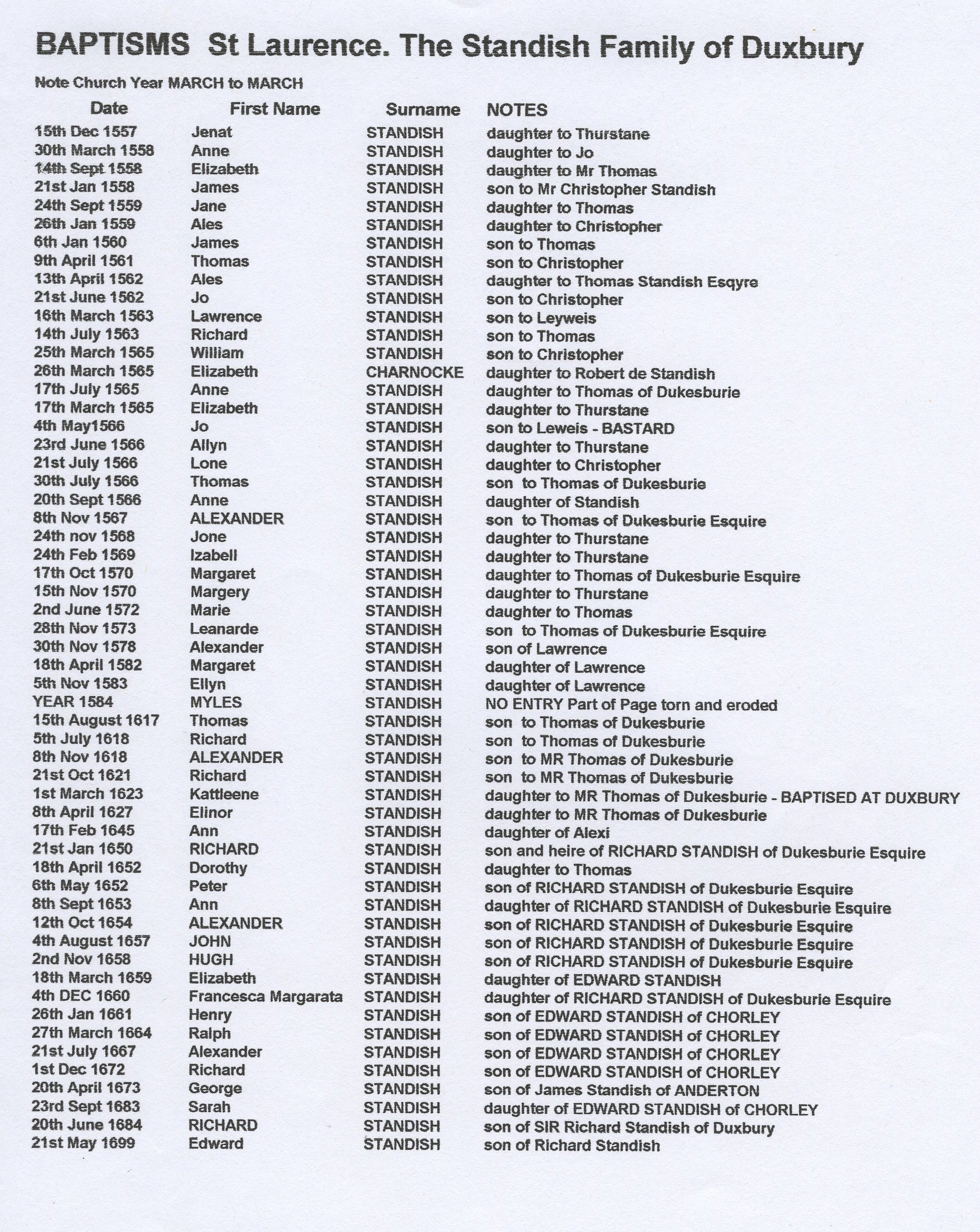
Parishes in the County of Lancashire
On Line Lancashire Family Surnames -: http://www.lan-opc.org.uk/indexp.html
- Webmaster .